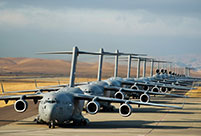 If you like autumn, put your hands in the air!
If you like autumn, put your hands in the air!
 Fan Bingbing's "Queen style" in new play
Fan Bingbing's "Queen style" in new play
 Lingerie show at 2014 Miss China
Lingerie show at 2014 Miss China
 J-10 fighters show aerobatic stunts in smog-free sky
J-10 fighters show aerobatic stunts in smog-free sky
 Charming contestants of Shanghai Int’l Model Contest
Charming contestants of Shanghai Int’l Model Contest
 Most amazing chi-pao beauties
Most amazing chi-pao beauties
 7 deadly animal attacks
7 deadly animal attacks
 Picturesque autumn scenery of Hongshan Army Horse Ranch
Russia to launch 70 Proton rockets by 2020: official
Picturesque autumn scenery of Hongshan Army Horse Ranch
Russia to launch 70 Proton rockets by 2020: officialThe busy sea lanes of the South China Sea are a miniature of the grand economic and social background in Asia, where regional cooperation and common development are being positively pursued and achieved by China and all ASEAN countries. Ignoring this grand background, people can easily become misled and misguided while dealing with the South China Sea issue.
The 8th Senior Officials' Meeting on the Implementation of the Declaration on the Conduct of Parties in the South China Sea (DOC) was held in Thailand on Oct. 28 and 29. All parties confirmed the 'two-track thinking' formerly proposed by China in dealing with South China Sea issues. The thinking is that all disputes should be settled through consultations and negotiations by the countries directly concerned, and China and ASEAN countries should jointly safeguard peace and stability in the South China Sea.
For some time, though western media have been deliberately trying to engineer a tense atmosphere in the South China Sea, talks and negotiations between China and other related countries to deal with South China Sea issues have continued to bear fruit and to produce concrete results. These efforts positively contribute to peace and stability in the South China Sea and Asia.
The South China Sea is an important international shipping channel between the Pacific and the Indian Ocean. It connects East Asia, the Middle East, Africa and Europe. According to statistics from the United States Council on Foreign Relations, every eight years, the total amount of goods passing through the South China Sea can reach 5.3 trillion dollars. Although some aspersions are still cast, there is clearly no barrier to freedom of navigation. The enormous freight volume is conclusive evidence of an overall stability in the area. In a report released in 2013 by the United Nations Conference on Trade and Development (UNCTAD), it was said that the proportion of shipping goods loaded in Asian harbors makes up 39 percent of the world's total. 57 percent of worldwide shipping goods are discharged at Asian ports. And most of this trade passes through the South China Sea.
The heavy traffic on the South China Sea is a miniature of the grand economic and social background in Asia, where regional cooperation and common development are positively pursued and achieved by China and all ASEAN countries. Ignoring this grand background, people can easily become misled and misguided while dealing with the South China Sea issue. Disputes and cooperation both exist in the area. To allow a few issues to discourage cooperation among China and ASEAN countries will do certain damage to the common interests of the countries and the region.
The more complex the South China Sea issue is, the more essential it is that friendly negotiations should be held among all countries involved. It is not only effective and feasible, but in accordance with international law and international practice. Also, peace and stability in the South China Sea region should be incorporated into a framework of closer cooperation with mutual benefit. In consideration of such factors, China advocates a 'two-track thinking', which is also strongly supported by the ASEAN countries.
The South China Sea's stability, its past, present and future rely on the joint efforts of China and the ASEAN countries. Only if we work together can we enjoy and share the gains of peace. It has proved to be true that 'two-track thinking' can effectively control and properly handle disputes. The same thinking can maintain proper stability and the general situation in the region.
As a community of common fate, interests and responsibilities, China and ASEAN countries need to work together to maintain peace and stability in the South China Sea. As a responsible world power, China is willing to devote its efforts together with the ASEAN countries to comprehensively and effectively implement the Declaration on the Conduct of Parties in the South China Sea, continuously promote negotiations about code of conduct in South China Sea, and strive for an early agreement on the code on the basis of consensus through consultation.
The article is edited and translated from《人民日報鐘聲:以“雙軌思路”維護南海和平穩(wěn)定》source: People's Daily
 World Pole Dance Championship in China
World Pole Dance Championship in China U.S. air force transport planes row up on base
U.S. air force transport planes row up on base Post-85s female pilots and their mission
Post-85s female pilots and their mission Century-old public bath closes door in Beijing
Century-old public bath closes door in Beijing Shocking! Photos of Chinese fighters revealed
Shocking! Photos of Chinese fighters revealed Images of angels in white: At work v.s off work
Images of angels in white: At work v.s off work  Standard faces for each countries in the world
Standard faces for each countries in the world Netizens fall in love with champion swimmer Ning Zetao
Netizens fall in love with champion swimmer Ning Zetao Vibrant 21-year-old and her own Cheongsam brand
Vibrant 21-year-old and her own Cheongsam brand Top 10 most dangerous jobs in the world
Top 10 most dangerous jobs in the world  Top 10 fifth generation jet fighters in the world
Top 10 fifth generation jet fighters in the world Top 10 Chinese goddesses
Top 10 Chinese goddesses  Top 20 hottest women in the world in 2014
Top 20 hottest women in the world in 2014 Top 10 pure beauties in showbiz
Top 10 pure beauties in showbiz  Top 10 world's highest-paid models 2014
Top 10 world's highest-paid models 2014 The most gorgeous Chinese women
The most gorgeous Chinese women Top 10 most handsome faces in Asia
Top 10 most handsome faces in AsiaDay|Week|Month